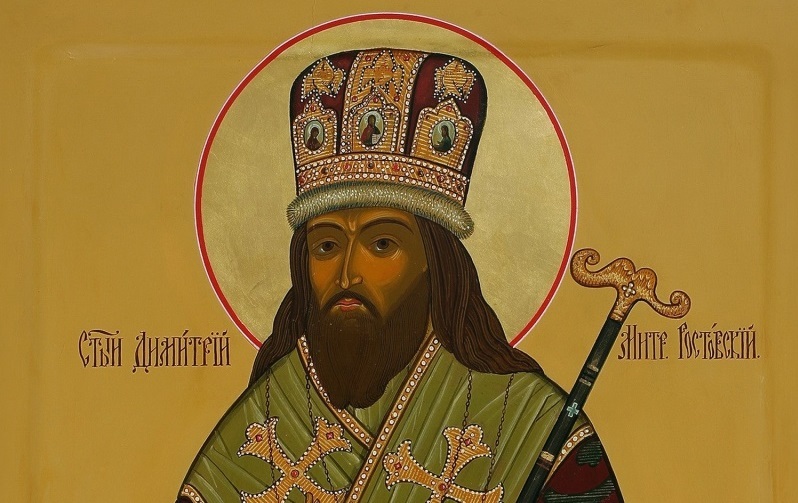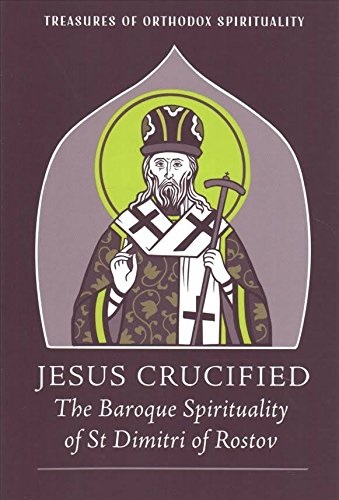
By Bruce Seraphim Foltz
Jesus Crucified: The Baroque Spirituality of St Dimitri of Rostov, (Treasures of Orthodox Spirituality), edited and translated by John Mikitish, St Vladimir’s Seminary Press, Yonkers, New York: 2017, pp. 170.
“Open, O doors and bolts of my heart that Christ the King of Gory may enter!
Enter, O my Light and enlighten my darkness;
Enter, O my Life, and resurrect my deadness;
Enter, O my Physician, and heal my wounds;
Enter, O Divine Fire, and burn up the thorns of my sins;
Ignite my inward parts and my heart with the flame of thy love;
Enter, O my King, and destroy in me the kingdom of sin;
Sit on the throne of my heart and alone reign in me,
O thou, my King and Lord.
—A Prayer by St Dimitri of Rostov
St Vladimir’s Seminary Press has inaugurated its new series, “Treasures of Orthodox Spirituality,” with this sparkling introduction to the very distinctive spirituality of St Dimitri of Rostov (1651-1709), a figure whose eloquence earned him during his lifetime the title “Russia’s Chrysostom.” Best known for his prodigious Compendium of the Saints in twelve volumes, which became a household companion throughout the Russian lands for two centuries, he was also an abbot and a much beloved bishop, a renowned preacher, and a composer of note whose melodies still resonate in Ukrainian folk songs. But he is less well known for his devotional writings, some of the finest of which are translated for the first time into English in this volume.
Along with a substantial and very helpful introduction by the translator, the book offers 18 selections, of varying lengths, of St Dimitri’s writings, all devoted to the suffering of Christ during His Passion, along with two appendices of additional works, the first a letter from filled with Paschal joy and the second a late nineteenth century psalm to St Dimitri himself. Most of these writings are intended for private devotional use, although several are poetic works that stand on their own. They are powerful, colorful, moving, and engaging. And above all, they exhibit an eloquence that comes not from rhetorical polish, but from the depths of the heart. Indeed, these writings possess something rare and wonderful: the power to move and warm the heart. In the words of Fr. Seraphim Rose, for the Orthodox faithful, “the first priority is the heart, which must be soft and warm. If we do not have this warm heart, we must ask God to give it, trying ourselves to do those things by which we can acquire it. Most of all, we have to see that we have not got it—that we are cold.”
Many Orthodox, however, will find precisely this quality problematic, because these writing are often, at least stylistically, reminiscent of the “baroque” spirituality of the Roman Catholic Counter Reformation and the writings of such figures as Ignatius of Loyola and Francis de Sales. This is not surprising, given St Dimitri’s Kievan roots both in his upbringing and his education at the Kiev Academy, whose classes were taught in Latin and which featured texts of Roman Catholic authors. As such, St Dimitri’s writings offer a kind of bridge between Latin and Russian spiritual worlds, perhaps one that is more promising than the philosophical bridges that some are seeking to construct today. For in these writings we find not a spirituality of the monastic cell, which to laity can at first seem (quite misleadingly) cold and austere, but a popular spirituality, one of the affective life, one that brings us immediately closer to their subject matter, the terrible, heart-wrenching, unthinkable, astonishing sufferings of our Lord.
But is this not at the same time a spiritual backsliding, a “Western captivity,” a regression to the sensualism and emotionalism of the Latin spiritual world, the fruit of a “Latin pseudomorphosis” of Orthodoxy into something other than itself? Not surprisingly, Fr Georges Florovsky thought so, seeing him as part of “ an acute Romanization of Orthodoxy” led by Kievan Metropolitan Peter Mohyla. While acknowledging that “in his spiritual life, St Dimitrii [sic] was not confined to the narrow mold of a Latin world,” Florovsky goes on to conclude that “as a thinker and writer he was never able to free himself from the mental habits and forms of theological pseudo-Classicism acquired when at school in Kiev.” Moreover, it would seem that such devotional writings stimulate the imagination in ways that Orthodox spiritual fathers have always cautioned against as a source of spiritual delusion (plani or prelest). Indeed, Fr Sergei Sveshnikov has written an excellent book (Imagine That: Mental Imagery in Eastern Orthodox and Roman Catholic private devotion through the writings of great saints) arguing that such encouragement of the imagination is a watershed between Orthodox and Western spiritual paths, one that cannot be glibly bridged.
But others disagree. St Nikolai Velimirovich saw him as “a great light of the Russian Church and of Orthodoxy in general” and “a saint in the ancient and true model of the early Fathers.” And Metropolitan Hilarion (Alfeyev) mounts a spirited defense of St Dimitri along with St Tikhon of Zadonsk, who was also shaped by Western sources. Insisting (contra Florovsky) that “the universal Orthodox tradition is wider than Byzantinism,” he argues that Orthodoxy finds not just Greek, but Russian, Syrian, Coptic, and indeed Western contexts in which to express itself, each mode needing to be understood within its own horizons. And we must not forget that St Dimitri of Rostov is a saint of the Church, with three Feast Days (including the Synaxis of the Saints of Rostov) in his honor, and that his holy relics have long been miracle-working.
Nevertheless, Florovsky’s cautions, while indeed too restrictive, should not be abandoned altogether. What are the criteria that would allow us to decide what modes of spiritual (and indeed, intellectual) expression are appropriate to Orthodoxy and which are not? And how do we go about deciding? Clearly, a kind of sobornost is needed that is able to enter into different tradition and “discern the spirits.” This can, and much needs to be, pursued as a goal. And these engaging texts by St Dimitri of Rostov constitute a fine place to begin the task.

About the Author
-
Bruce Seraphim Foltz taught Philosophy at Eckerd College in St. Petersburg, Florida, and served as Founding President of the International Association for Environmental Philosophy. He is the author of Inhabiting the Earth: Heidegger, Environmental Ethics, and the Metaphysics of Nature (Humanities Press) and The Noetics of Nature: Environmental Philosophy and the Holy Beauty of the Visible (Fordham University Press), as well as coeditor of Toward an Ecology of Transfiguration: Orthodox Christian Perspectives on Environment, Nature, and Creation (Fordham University Press).
- April 5, 2018ArticlesWords to Warm the Heart. A Review of “Jesus Crucified: The Baroque Spirituality of St Dimitri of Rostov”
- December 29, 2017Notes from Above GroundLooking for the Real Jesus? Try the Gospels
- December 12, 2017ArticlesHow to Read and Study Dostoevsky
- September 17, 2017In DepthNature and City in the Greek East

